Stay informed with free updates
Simply sign up to the Currencies myFT Digest — delivered directly to your inbox.
Europe is getting a little taster of a high-class problem: the downsides that come with operating a world-beating reserve currency.
For now, the continent is not quite in this luxury spot. The euro accounts for a far smaller slice of the stashes of cash maintained by central banks and similar entities around the world than the dollar, and its prevalence in global trade is puny in comparison.
Still, policymakers clearly have their eyes on the prize of a beefed-up role for the euro, and it would be unwise to bet against it. All things being equal, this means the euro is on the way up.
One warning on what this might all mean came from Scott Bessent, US Treasury secretary, who said this month that Europe “should be careful what they wish for”. If the euro rises as high as $1.20 (it’s at around $1.17 now), “Europeans are going to be squawking that it’s too strong”, he said. In fact the squawking is already under way.
The euro has been one of the biggest beneficiaries of Donald Trump’s drive-by on the dollar this year. All major currencies have appreciated against the buck, but the euro more than most, up by over 13 per cent in 2025 so far.
In part this is because of the European renaissance trade, encompassing both European Central Bank president Christine Lagarde’s “global euro moment” and the possibility of a long-awaited economic growth revival stemming from Germany’s decision to stop worrying and ramp up fiscal spending.
It has another curious cause, though. Stocks investors around the world are unusually keen to shield themselves from further weakness in the dollar — a risk they had quite reasonably previously ignored. For fund managers based in small economies, this can be expensive and awkward in their fiddly home currency. A shortcut is just to buy euros, and analysts say that is precisely what they are doing, regardless of where those investors are based.
This is all well and good for those fund managers in stocks, but in financial markets, we cannot have nice things. Someone has to feel the pain. In this case, it is corporate Europe, exporters in particular, who are stung by the euro’s ascent against the dollar and renminbi, which makes European exports appear more expensive overseas.
Researchers at Barclays point out that strength in the euro is one of the main reasons why analysts have been slashing earnings expectations for listed European companies this year. Outlooks for growth in earnings per share have dropped from 9 per cent all the way down to 2 per cent, and exporting companies lag far behind their domestic-focused peers in their share-price performance so far this year.
“Typically, euro strength if it comes with a stronger growth backdrop as in 2017 or 2020-21, then it is not a big headwind,” said Magesh Kumar at the bank. “This time around we are looking at a weaker growth backdrop in [the second half of the year] from the tariff impact and a simultaneously stronger euro. So it’s a double whammy to earnings.” With several national European stock indices up by more than 20 per cent so far this year, it is not hard to imagine the strong euro tapping on the brakes here.
Officials at the ECB are also getting a little twitchy. An overly strong euro depresses import prices while also hampering exports, dragging down inflation. This puts rate-setters in a bind. They don’t want to aim for specific exchange rates, which puts a target on their back and in any case is a mug’s game given the volatility of currency markets. But they do often want to gently massage the currency lower with a series of winks and nods. This is an awkward path, as the central bank found in the years following the great financial crisis of 2008, when the euro bobbed around between $1.30 and $1.60.
Now, as ECB vice-president Luis de Guindos said this month, “we should try to avoid any sort of overshooting” in the euro against the dollar. Stretching meaningfully higher from here would be, he said, “complicated”.
Indeed, the ECB has already cited “a stronger euro” as an input into the decision to cut interest rates by a quarter of a percentage point in June, pinned on downward revisions to inflation projections. Without the rise in the euro, this cut may never have happened.
Right now, conditions in the currencies markets are orderly, the dollar is drifting lower rather than crashing, and the euro’s exchange rate is annoying rather than outright alarming. Cracking the next big round number — $1.20 — will almost certainly turn up the temperature. It feels like a question of when rather than if.
